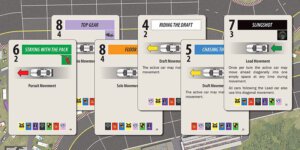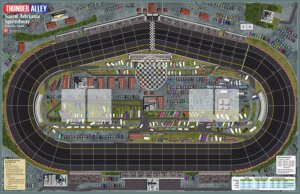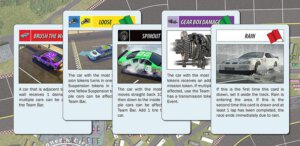
Publisher: GMT Games
Designers: Jeff and Carla Horger
Artists: Rodger B. MacGowan and Kurt Miller
Year: 2014
Genre: Stock car racing game featuring hand management
Players: Two to seven players
Ages: 10+
Playing Time: An hour and a half to two hours
MSRP: $64.00
Years ago, back when Gen Con was held in Milwaukee, I found myself involved in a tournament featuring a home brewed Formula One style racing game. Funny enough I didn’t have much interest in auto racing, or even games of that style even though I owned Avalon Hill’s Indy 500, but on that fateful day twenty some years ago I had a spare generic convention ticket and was looking to get into something – anything – to play that Saturday afternoon. In essence I stumbled into this game and after winning the race during that play session ended up making it into the finals later that evening. Through a bit of skill and, no doubt, plenty of luck I ended up winning the tournament and with that a four and a half foot tall trophy which I proceeded to drag around with me through the convention center; I swear people must have thought I’d won a Magic: The Gathering tournament (this was the Gen Con following M:TG’s breakout) by all the stares I, and the aforementioned trophy, got that night.
I bring up this prior event mainly because one thing that always stuck with me about that homebrewed game was the use of a hand of cards to not only facilitate the movement of your vehicle but all the other cars in the race also. I seem to recall some rather basic rules involving drafting and slingshotting around a track consisting of movement boxes but I can’t say the game was complex by any stretch. In the years after I played a few racing games which were very similar. Fast forward a couple decades or so when I notice a game on GMT’s P500 preorder system by the name of Thunder Alley. From what I gathered about Thunder Alley, it was to be a stock car racing game which would utilize cards to maneuver the racing field and that piqued my interest. I’ll get to my thoughts about the game in just a bit but first let’s see what you’ll find when you crack open the box.

The rules are some of the shorter ones you’ll encounter from GMT as they clock in at only sixteen pages. I believe it’s important to point out Thunder Alley is a departure from what one could consider GMT’s bread and butter (wargames) and though the rules have a higher page count than that the title’s target audience may expect they’re fairly concise if sometimes not crystal clear.
You might notice I’m using the generic term “stock car racing” and you’ll find no mention of the word NASCAR in Thunder Alley either since the game doesn’t carry the racing giant’s license. Those familiar with all things GMT may be surprised to find there isn’t the usual amount background info and details about the subject of stock car racing but one has to keep in mind there isn’t that NASCAR license so any sort of history of that sport association is “off the table” so to speak. Of course I can use the word so… NASCAR! NASCAR! NASCAR! Regardless, Jeff and Carla Horger’s design is clearly set in the world of NASCAR and that specific style of auto racing. The focus of each player in Thunder Alley is to have their racing team, as opposed to one car finishing first, total the best results in a race overall.

To get onto the racing in Thunder Alley players will select a track, choose one of the seven equally matched racing teams and select their cars. Depending on how many players are taking part you could control anywhere from three to six vehicles in the game. You’ll shuffle up both the Race Deck and Event Deck of cards, receive a number of Race cards equal to the number of cars you control plus an additional card and get ready to fill out the field. Since there aren’t any dice used in Thunder Alley the bottom of each Race card contains a stripe of colored symbols, which are used to resolve any number of events requiring a random result, and this stripe will determine the order in which the teams will line up for the race start.
Each game turn breaks down as follows:
Fill Your Hand – Following the first turn, the players will refill their hands with Race cards. Regardless of a player’s cars being eliminated or not everyone will continue to draw the same number of cards. If the Race Deck runs out you simply reshuffle the discards to refresh the deck.
Perform Actions – This is the heart of Thunder Alley as the players take turns activating their cars and performing movement. Each of the Race cards contain quite a bit of information including some flavor text to give you a feel for the aim of the card, how many movement points the vehicle can use (cars expend a movement point, or more, to enter each track space), what sort of movement is represented by the card, possible special effects, as well as any wear the vehicle receives by playing the card. In turn, all players will go around the table activating a single vehicle, or passing for every car out of the race, until all vehicles have been accounted for.

Wear can also begin to pile up on you cars which will eventually handicap their performance or even knock it out of the race. Wear can be temporary or permanent. Temporary Wear can be removed to going to the pit while permanent Wear stays with the car throughout the race. While there isn’t really isn’t any sort of minutia aimed at crashes in Thunder Alley, although there are some Event cards which will add Wear markers to certain cars, the accumulation of Wear represents some of that “rubbing is racing” concept in NASCAR along with the usual breakdown of tires and expenditure of fuel requiring pit stops.
Perform End of Turn Sequence – Players determine who the Turn Leader is and award that player a marker representing that fact, draw an Event card and resolve what the card indicates – unless a car has crossed the finish line, give the race leader the first player marker, remove any cars which have been lapped, and allow anyone to discard any unwanted Race cards.
Once a car has crossed the finish line during the final lap that vehicle will be awarded the first place marker and then the current phase of actions will be played out. As each car passes the finish line they’ll be awarded the next finish marker (2nd, 3rd, 4th, etc…) and once the actions are completed any cars remaining on the track will be assigned a finish marker based on their current running. Everyone will then tally up their points received based on the finish markers, as well as bonuses for leading turns and most laps led, and the player with the highest score is the winner.

For the most part Thunder Alley is easy to understand and get into, as the rules do include some examples to keep things clear, but there are a couple of items which can be a bit tricky until you get the hang of things or agree must be the correct procedure. First is the movement system itself. While drafting, pursuit, and lead movement aren’t especially difficult to understand you have to pay close attention to displacing cars (pushing them out of the space where another car ends movement) as well as drafting into corners. It took a bit of mulling over to make sure we were moving the cars correctly.
The second item which requires special mention is the mechanic involving lapped cars. Since these vehicles will be removed at the end of the current turn if they stay lapped, you want to keep in mind they’re only lapped if they finish the turn with a lapped counter. They’re only lapped if the turn ends and they finish behind the car which BEGAN that turn as the leader and in the same lane, not sitting behind the car which will be the new leader at the end of the turn. In effect, if the cars can’t pass the driver who began the turn as the leader they’ll be removed. Or at least that’s what we got out of it because the rules really aren’t especially clear and the text reads:
“When the car possessing the Leader marker moves into the same sector as another car(s), that car(s) is considered lapped. Place a Lap-down marker on the lapped car(s). If a car with a Lap-down marker moves into a sector in front of the leader, the Lap-down marker is removed. If a car ends a Turn with a Lap-down marker still on it, the car is removed and awarded the lowest value Position Marker remaining based on the order of its finish…”

I’ll guess some readers will be thinking here’s where Jeff unloads on Thunder Alley. Happily I can say that’s not going to be the case but it’s important to note there are some problems with the rules presentation where a little more explanation would be appreciated. I think part of the problem lies with GMT having so many different games in the pipeline and no one, two, or three dedicated game developers assigned to specific titles alone so mistakes are slipping under the radar just as games are going to print. That’s a tale for another time though and really doesn’t have a whole lot to do with Thunder Alley precisely.
I began this review by mentioning I’m not an auto racing fan. Honestly I’m not much of a “car guy” either as my line of thought is along the lines of Steve Martin when trying to rent a car in Planes, Trains, and Automobiles. Yet Thunder Alley is a fantastic game which only misses out on a 10/10 because of the errata and game board issues. Even though the cars only make a couple laps or so around the board you really have a sense of a race taking place with speed and maneuvering. Rather than a game of simple movement Thunder Alley turns out to be more about hand management than anything else. This is why losing a car or two from your team during a race can be a desirable thing (depending on when it takes place) since you’ll still draw the same number of cards each turn so you get to pick and choose what card you play and when.

It’s really saying something when I have no interest in NASCAR, or Indy racing for that matter, but still feel Thunder Alley is one of the most engaging games of the year. While obviously the card mechanics draw inspiration from plenty of other racings games such as Formel 1 and Detroit-Cleveland Grand Prix (truth be told so did that homebrew game so many years ago) there’s a lot of freshness to the design as well. Anyone with any sort of interest in racing games will owe it to themselves to get their hands on Thunder Alley while even those who’re like me who don’t follow those sports will have a great time too. I’ll definitely be on the lookout for Jeff and Carla Horger’s proposed Formula One game which is supposed to be on the horizon!
[rwp-review id=”0″]
- Pinebox, TX Middle School Boxed Set Reviewed - Dec 24, 2024
- Score Big Savings with the Fifty-Dungeon Bundle of Holding - Dec 24, 2024
- The ACKS II Revised Rulebook Lands in PDF - Dec 24, 2024

















